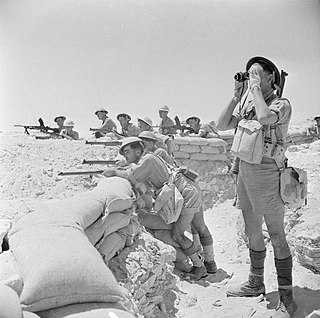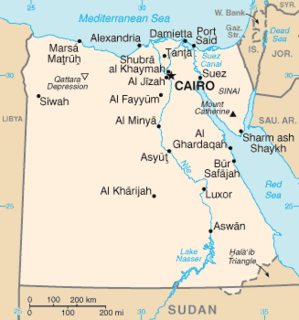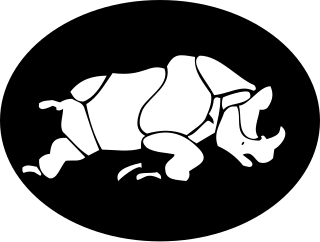
The First Battle of El Alamein was a battle of the Western Desert Campaign of the Second World War, fought in Egypt between Axis forces of the Panzer Army Africa and Allied forces of the Eighth Army.

The Second Battle of El Alamein was a battle of the Second World War that took place near the Egyptian railway halt of El Alamein. The First Battle of El Alamein and the Battle of Alam el Halfa had prevented the Axis from advancing further into Egypt.

The Battle of Bir Hakeim took place at Bir Hakeim, an oasis in the Libyan desert south and west of Tobruk, during the Battle of Gazala. The 1st Free French Brigade under Général de brigade Marie-Pierre Kœnig defended the position from 26 May – 11 June against Axis forces of Panzerarmee Afrika commanded by Generaloberst Erwin Rommel. The Panzerarmee captured Tobruk ten days later.

Egypt was a major battlefield in the North African campaign during the Second World War, being the location of the First and Second Battles of El Alamein. Legally an independent kingdom, and an equal sovereign power in the condominium of Anglo-Egyptian Sudan, in reality Egypt was heavily under the coercive influence of the United Kingdom, a state of affairs that had persisted since the United Kingdom intervened militarily in the Orabi Revolt in favour of Egypt's Khedive, Tewfik Pasha, in 1882, subsequently occupying the country. The continuing British dominance of Egyptian affairs, including British efforts to exclude Egypt from the governance of Sudan, provoked fierce Egyptian nationalist opposition to the United Kingdom. Consequently, despite playing host to thousands of British troops following the outbreak of the conflict, as it was treaty bound to do, Egypt remained formally neutral during the war, only declaring war on the Axis powers in the spring of 1945. Though escaping the fate of Iraq, and Iran, both of whose governments were toppled by the United Kingdom during the war, Egypt experienced the Abdeen Palace Incident, a confrontation between Egypt's King Farouk and the British military in 1942, the results of which would contribute directly to the Egyptian Revolution of 1952 a decade later.

The 2nd New Zealand Division, initially the New Zealand Division, was an infantry division of the New Zealand Military Forces during the Second World War. The division was commanded for most of its existence by Lieutenant-General Bernard C. Freyberg. It fought in Greece, Crete, the Western Desert and Italy. In the Western Desert Campaign, the division played a prominent role in the defeat of German and Italian forces in the Second Battle of El Alamein and the British Eighth Army's advance to Tunisia.

XXX Corps was a corps of the British Army during the Second World War. The Corps was formed in the Western Desert in September 1941. It provided extensive service in the North African Campaign and many of its units were in action at the Second Battle of El Alamein in late 1942. It then took part in the Tunisia Campaign and formed the left flank during the Allied invasion of Sicily in 1943.

The Western Desert campaign took place in the deserts of Egypt and Libya and was the main theatre in the North African campaign of the Second World War. Military operations began in June 1940 with the Italian declaration of war and the Italian invasion of Egypt from Libya in September. Operation Compass, a five-day British raid in December 1940, led to the destruction of the Italian 10th Army. Benito Mussolini sought help from Adolf Hitler, who sent a small German force to Tripoli under Directive 22. The Afrika Korps was formally under Italian command, as Italy was the main Axis power in the Mediterranean and North Africa.

The Battle of Alam el Halfa took place between 30 August and 5 September 1942 south of El Alamein during the Western Desert Campaign of the Second World War. Panzerarmee Afrika, attempted an envelopment of the British Eighth Army. In Unternehmen Brandung, the last big Axis offensive of the Western Desert Campaign, Rommel intended to defeat the Eighth Army before Allied reinforcements arrived.

The Battle of Gazala was fought during the Western Desert Campaign of the Second World War, west of the port of Tobruk in Libya, from 26 May to 21 June 1942. Axis troops of the Panzerarmee Afrika consisting of German and Italian units fought the British Eighth Army composed mainly of British Commonwealth, Indian and Free French troops.

The Defence of Outpost Snipe in Egypt, took place in the Second Battle of El Alamein, part of the Western Desert campaign during the Second World War. On the night of 26/27 October 1942, the 2nd Battalion of the Rifle Brigade, with thirteen 6-pounder anti-tank guns and the 239th Battery, 76th Anti-Tank Regiment, Royal Artillery, with six more 6-pounders, was ordered to occupy a desert feature known as Snipe, a small depression in the landscape 1.5 mi (2.4 km) south-west of Kidney Ridge that was suitable for an outpost. Once consolidated, it could be used as a jumping-off point for an advance by the 24th Armoured Brigade.

A mine flail is a vehicle-mounted device that makes a safe path through a minefield by deliberately detonating land mines in front of the vehicle that carries it. They were first used by the British during World War II.

The Battle of Medenine was an Axis spoiling attack at Medenine in Tunisia on 6 March 1943. The operation was intended to delay an attack by the British Eighth Army on the Mareth Line. The British had been forewarned by Ultra decrypts of German wireless communications and rushed reinforcements from Tripoli and Benghazi before the Axis attack, which was a costly failure. General Erwin Rommel, the commander of Army Group Africa (Heeresgruppe Afrika), could not afford to lose forces needed for the defence of the Mareth Line and the effort was abandoned at dusk that day.

The 22nd Armoured Brigade was an armoured brigade of the British Army that saw service during and after the Second World War. The brigade was formed on the outbreak of war on 3 September 1939 from Territorial Army (TA) armoured regiments. It saw a considerable amount of action during the war, beginning with the Western Desert Campaign where it was engaged in Operation Crusader and at the Battles of Gazala, Mersa Matruh, First Alamein and Alam el Halfa. It then joined the 7th Armoured Division for the Second Battle of El Alamein. It remained part of 7th Armoured for the rest of the war, including the campaigns in Tunisia, Italy and North West Europe. It continued in the postwar TA until 1956. The brigade's identity was re-established in the Regular Army between 1981 and 1993.

The 9th Armoured Brigade was a British Army brigade formed during the Second World War.

The Battle of El Agheila was a brief engagement of the Western Desert Campaign of the Second World War. It took place in December 1942 between Allied forces of the Eighth Army and the Axis forces of the German-Italian Panzer Army, during the long Axis withdrawal from El Alamein to Tunis. It ended with the German-Italian Panzer Army resuming its retreat towards Tunisia, where the Tunisia Campaign had begun with Operation Torch (8–16 November 1942).

The Battle of Mersa Matruh was fought from 26 to 29 June 1942, following the defeat of the Eighth Army at the Battle of Gazala and was part of the Western Desert Campaign of the Second World War. The combatant on the Axis side was the Panzer Army Afrika (Panzerarmee Afrika, consisting of German and Italian units. The Allied forces of the Eighth Army comprised X Corps and XIII Corps. The battle developed as the Afrika Korps pursued the Eighth Army as it retreated into Egypt. Rommel intended to engage and destroy the Allied infantry formations in detail, before the British had a chance to regroup. The Axis cut off the line of retreat of X Corps and XIII Corps but was too weak to stop the British from breaking out. The fortress port of Mersa Matruh and 6,000 prisoners were captured, along with a great deal of supplies and equipment but the Eighth Army survived.

The 17th Infantry Division "Pavia" was an infantry division of the Royal Italian Army during World War II. The Pavia was formed in on 27 April 1939 and named after the city of Pavia. The Pavia was classified as an auto-transportable division, meaning it had some motorized transport, but not enough to move the entire division at once. The Pavia had its recruiting area and regimental depots in the Romagna and its headquarters in Ravenna. Its two infantry regiments were based in Cesena (27th) and Ravenna (28th), with the division's artillery regiment based in Ravenna. Shortly after its formation the division was sent to Sabratha in Italian Libya. It participated in the Western Desert campaign and was destroyed during the Second Battle of El Alamein.

The Battle of Rimini took place between 13 and 21 September 1944 during Operation Olive, the main Allied offensive on the Gothic Line in August and September 1944, part of the Italian Campaign in the Second World War. Rimini, a town on the Adriatic coast of Italy, anchored the Rimini Line, a German defensive line which was the third such line forming the Gothic Line defences.

The 1st Armoured Division was an armoured division of the British Army. It was formed in November 1937, as the Mobile Division, after years of debate on the creation of such a formation. Over the following three years, its intended role and structure were finalised. With the outbreak of the Second World War, in September 1939, it was steadily drained of resources that were used to reinforce the British Expeditionary Force (BEF) or to create new formations. In May 1940, after the Battle of France began, it was deployed to France. It was unable to reinforce the BEF, which was heavily engaged fighting near the Belgium border, and was landed at Cherbourg. Due to the German advance, the division was stuck to the west of the Somme and made several attempts to push east to the BEF and lost large numbers of tanks in the process. As the strategic situation worsened, the BEF was withdrawn from France from Dunkirk, and the division withdrew from ports in Normandy and Brittany during Operation Aerial.

The Axis capture of Tobruk, also known as the Fall of Tobruk and the Second Battle of Tobruk was part of the Western Desert campaign in Libya during the Second World War. The battle was fought by the Panzerarmee Afrika, a German–Italian military force in north Africa which included the Afrika Korps, against the British Eighth Army which comprised contingents from Britain, India, South Africa and other Allied nations.




















